Evolving Key Account Manager Role in 2026: AI Skills, Habits & Mindsets Guide
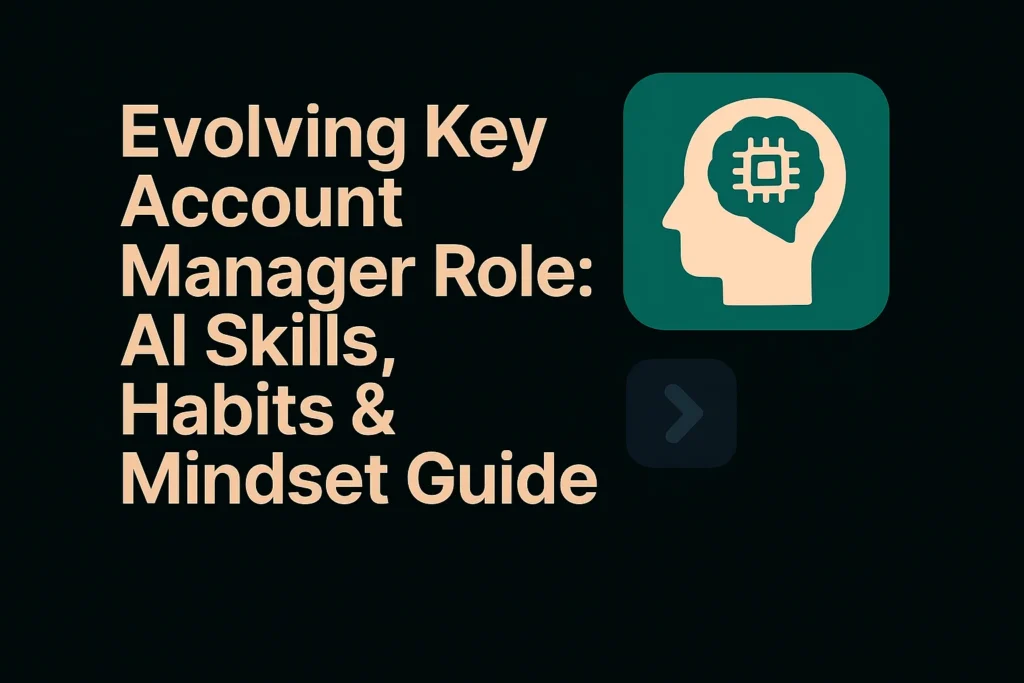
If there is one truth 2025 has made painfully clear, it is this: AI is not coming for Key Account Managers, but it is ruthlessly exposing who is truly strategic and who was surviving on memory, relationships, and hustle alone. This perspective comes from a 25+ year journey in Key Account Management (KAM) and the last decade building DemandFarm and Kampanion with enterprise teams across the US and Europe. The pattern is consistent: the best AMs are not the ones who “know AI tools”; they are the ones who know how to think, decide, and execute in partnership with AI. In 2026 and beyond, that is what “AI-ready” really means, and it is redefining the key account manager role. The new reality: Relationships still win, but systems decide the pace For years, Account Management was dominated by the “hero AM” archetype: -> Strong relationships -> Sharp instincts -> An ability to “just get it done” Those strengths still matter. But in a world where: -> Every email, call, and meeting is captured and analyzed -> Stakeholder moves are tracked automatically -> AI can synthesize patterns across thousands of accounts in seconds The differentiator is shifting from “Who knows the customer best?” to “Who can turn all of this intelligence into the right moves, at the right time, with the right people?” The AI-ready Key Account Manager sits precisely at that intersection. 3 Key Account Management trends in 2026 every team must recognize 1. From data scarcity to intelligent overwhelm The old complaint: “We don’t have enough data to know what’s going on.” The 2026 complaint: “We have too much data and too many dashboards.” AI now makes it trivial to generate Health scores, Engagement heatmaps, Whitespace views, Propensity-to-buy and churn-risk predictions. The problem is no longer access; it is discernment. The AI-ready AM learns to: -> Ignore 80% of the noise -> Focus on the handful of signals that truly predict risk, opportunity, or stakeholder change -> Ask better questions of the system instead of passively consuming whatever it shows In other words, data literacy becomes as important as relationship literacy. 2. From lone hero to orchestrator-in-chief In B2B enterprises, a single key account now spans multiple teams: sales, customer success and support, marketing, product and delivery, plus partners and the wider ecosystem. AI will only increase this interconnectedness by surfacing dependencies and conflicts more clearly. The days of a single AM quietly “owning” everything are over. The AI-ready AM evolves into an orchestrator: -> Aligning internal teams around one account narrative -> Ensuring AI-driven insights are shared and acted on across functions -> Using data to coordinate, not to hoard power The hero story shifts from “I closed the deal” to “We grew this account together, intentionally.” 3. From static plans to living, AI-augmented strategy Traditional account plans were: -> Built in PPT, docs, or spreadsheets -> Updated before major account reviews -> Forgotten in between Today, AI-enhanced KAM platforms make it possible for org charts, risk indicators, whitespace, and key growth initiatives to evolve in near real time. A plan is no longer a document; it is a living system. The AI-ready AM treats the account plan like a cockpit: -> Something to be checked weekly -> A shared operating system for leadership, RevOps, and adjacent teams -> A place where human judgment and machine intelligence meet The 2026 AI-ready Key Account Manager: A capability model The AI-ready AM framework (2026) spans skills, habits, and mindsets. This is practical for AM self-evaluation, leader hiring/development, and SalesOps / RevOps enablement planning. Pillar 1: Skills: What the AI-ready AM can do 1. Data-literate, not data-scientist AI-ready AMs don’t build models but they should understand: -> What a health score is (and isn’t) -> Which leading indicators correlate with renewals or expansion in their segment -> How to challenge a suspicious insight instead of blindly trusting it They can sit in account reviews with leadership, explain the story behind the numbers, and confidently say, “Here’s what the data is telling us, and here’s what it’s missing.” 2. Scenario and portfolio thinking Instead of optimizing one opportunity/deal at a time, AI-ready AMs think in scenarios: -> “What happens to my annual number if this one anchor account reduces spend by 15%?” -> “What if we can move this one stakeholder from neutral to champion in the next 90 days?” With AI, these “what ifs” can be modeled quickly. The AM’s job is to: -> Choose which scenarios matter -> Translate them into concrete plays across their book of business This is especially critical in Europe, where a handful of strategic accounts often make or break regional targets. 3. Turning insights into narratives AI can generate pages of analysis, but customers and executives have attention for one clear, compelling story. The AI-ready AM excels at: -> Translating complex signals into simple storylines. “Here is what changed. Here is what it means. Here is what we propose.” -> Tailoring that narrative for different stakeholders—finance vs operations, US vs EU, executive sponsor vs day-to-day contact -> Using data to deepen trust, not to overwhelm or intimidate Narrative is where AI’s intelligence becomes human impact. Pillar 2: Habits: How the AI-ready AM works every week 4. A weekly “copilot” review ritual The AM of 2026 who thrives will likely have a simple, consistent habit: 30 minutes every week dedicated to: -> Reviewing AI-surfaced risks, whitespace, and stakeholder changes -> Cleaning up obvious data issues (duplicates, wrong roles, dead opportunities) -> Choosing a few moves that matter most for the coming week This ensures AI insights translate into motion, not just dashboards and screenshots. 5. Capturing human context as a discipline AI can see patterns in language and behavior, but it still does not sit in the room when someone says, “Off the record, the real decision-maker is in London, not New York.” AI-ready AMs: -> Capture short, structured notes after important interactions—politics, preferences, friction points, personal context -> Feed that back into their system
How I Killed My Own SaaS Product to Build AI-First Key Account Management Software
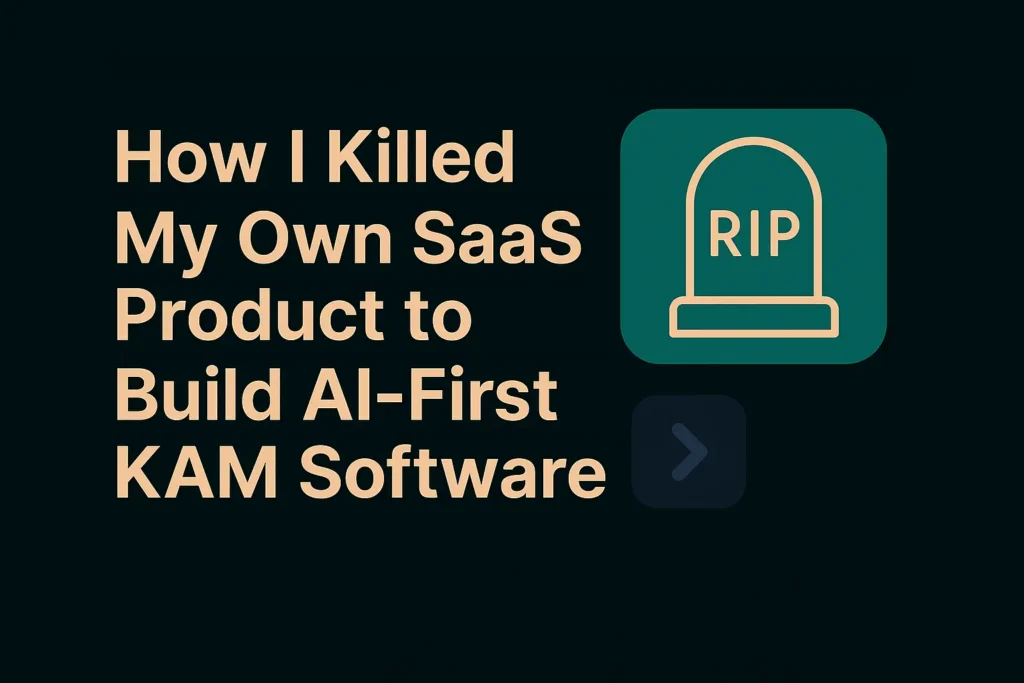
AI will not save lazy SaaS. And I say that as a founder who has spent a decade building SaaS for key account management and eventually killed it to rebuild an AI-first key account management software. The uncomfortable truth about SaaS and Key Account Management When we started DemandFarm, our tools/products were like most enterprise SaaS tools of that era: sophisticated systems of record for Sales Leaders. Leaders loved them because they got governance, structure, and reports. Users hated them because they had no choice but to do manual data entry. In key account management, that meant one thing: account managers spent more time feeding the system than getting help from it. The product behaved like a compliance layer, not a guide or a thinking partner. It was great for “What happened so far?” but terrible for “What should I do next in this account?” You could say a good key account manager should anyway know their next best move. But that is true for the top 10-20%. I always believed in something bigger: Democratizing Account Management. Shrinking the gap between the best and the average AM. Spreading winning patterns across all key accounts so growth is not a happy accident in a few logos, but a repeatable outcome across the strategic accounts portfolio. Then AI became real enough to matter, not just as a buzzword. And it forced a hard question in my mind: if we build on the same foundations and just add an AI wrapper, are we actually changing anything? My answer: no. Why “AI wrappers” for SaaS are a dead end The easy path for any SaaS founder right now is obvious: keep the same product, sprinkle some AI: -> Add a copilot bubble in the corner -> Auto-generate a few summaries -> Put “AI-powered” on the website But if the core product is still a system of record, AI becomes cosmetics. The workflow is unchanged. The user is still typing, cleaning, tagging, and updating. AI just makes the screen look modern. For key account management, that’s a waste. Account managers are already juggling politics, relationships, renewals, expansions, product complexity, and internal stakeholders. They don’t need yet another place to document reality. They need a system that understands the account with them and nudges them toward better moves. That’s where the idea crystallized for me: -> SaaS gave sales leadership systems of record. -> AI must give account managers/users systems of insight and action. And if that is true, then many of our own products had to eventually die. Deciding to “kill” our own product Inside DemandFarm, this was not a theoretical discussion. We had a mature product line, paying customers, and years of UX patterns built for a pre‑AI world. But every time I looked at how account managers actually worked, it bothered me: -> They still ran to PowerPoint for QBRs. -> They still kept “real” notes and strategies in their own docs. -> They updated the product mainly before reviews, not as a natural part of their weekly rhythm. If AI was going to be central, not decorative, we had two choices: 1. Retrofit AI into the old flows 2. Start again and design for an AI-first world Retrofitting would make us feel productive but not change the nature of work. So we chose the painful route: rebuild DemandFarm Kampanion from scratch and be willing to kill patterns that had “worked” for years. That decision changed everything. How I redesigned Kampanion from the ground up When we started redesigning Kampanion, I kept three constraints in my head: 1. Assume the account story already exists in scattered data and tools. 2. Assume the account manager’s time and attention are the scarcest resources. 3. Assume leadership wants the real truth, not staged theatre. From there, the design question became very simple: What if the account manager never typed a single thing into the system? What could AI figure out on its own? That forced a very different product: -> The starting point is data ingestion, not input forms for users. -> The default mode is “suggest, build, and ask for correction,” not “ask for inputs.” -> The primary artifacts are insights and actions, not fields and sections. Examples of how this showed up in Kampanion’s design: -> Instead of “Build an account plan,” Kampanion auto-assembles a living account narrative from CRM data, deals, products, emails, meetings, conversation intelligence, and external signals. The AM edits and adds nuance; they don’t start on a blank canvas. -> Instead of “Draw an org chart and relationship map,” Kampanion proposes a relationship map based on roles, touchpoints, and interaction history, and suggests additional contacts to be continuously added to the canvas. The AM fixes it where the machine is wrong. -> Instead of “Fill a white-space matrix,” Kampanion surfaces buying centers, where similar customers buy more, where adoption is shallow, where engagement is dropping, and turns those into “plays” the AM can pick up. The mental model flipped from: “System demands data, then gives reports” to “System mines data, then proposes moves.” From system of record to system of insights and actions The old world of KAM tools looked like this: -> At the start of the year, everyone fills plans to satisfy the process. -> Mid-year, reality diverges; plans stay static. -> Before QBRs, teams scramble to reconcile reality with the tool and slides. In that world, the “truth” of the account lived in decks, side conversations, and the AM’s head. The product was mostly an after-the-fact documentation tool. With Kampanion rebuilt as AI-first, the loop I wanted was very different: -> The system keeps learning about the account every week. -> It flags risks and opportunities as they emerge, not at quarter-end. -> It keeps a single, living, breathing narrative of the account that both AMs and leaders can trust. You should be able to ask at any time: -> “Where is this account likely to grow next?” -> “Which relationships are
Revegy’s Discontinuation: Your Guide to Selecting a Right Alternative Tool
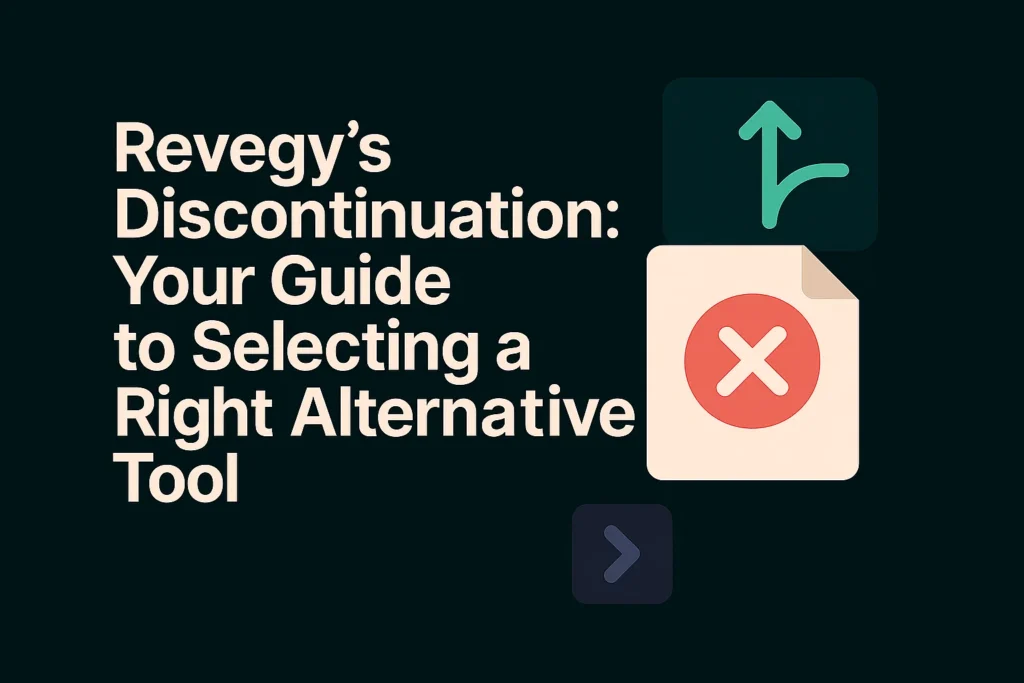
I was deeply saddened to hear about Revegy’s closure/discontinuation. It has only been a few months since we learned about Prolifiq’s discontinuation, so this news came as a shock. As a founder and someone who lives and breathes strategic account management, I understand what it takes to build a product and community that account managers (AM) rely on every day. It’s a tough moment for the Revegy team, and for every customer and partner who relied on their tool to drive growth. My sincere empathy goes out to the Revegy team and, above all, to their customers who are now faced with the challenge of finding a new, strategic Revegy Alternative for their account planning needs. Why Revegy Alternatives & Competitors Must Evolve Legacy account management systems, like Revegy or Prolifiq, helped move AMs beyond scattered spreadsheets and slides, but often at the cost of tedious manual data entry and static or outdated plans. They created “systems of record” for visibility, but added friction for the end users (sellers) who actually build relationships. I have personally worked closely with hundreds of strategic account management teams over the years, and one thing has become crystal clear to me is that sellers hate complexity, repetitive data entry, or another “AI-powered badge”. They need clarity and confidence, and a system that works with them, not against them. They need a tool that helps them win without adding layers of tedious manual data entry or overwhelming dashboards. That’s exactly why I started DemandFarm and started to solve for Account Managers. DemandFarm – A Revegy Alternative Purpose-Built For AI-First Account Management DemandFarm isn’t just another account management software that you add to your sales stack and silently hope for adoption and RoI. Our team partners with revenue growth teams not only to configure workflows and tailor-fit growth processes but to shape winning behaviors, high adoption, and actionable insights that stick across quarters and team changes. This is how real enablement lifts performance: by making sales tech an asset, not a chore. We have thoughtfully designed it to be an intelligent co-pilot for AMs. DemandFarm’s Kampanion AI is designed and trained to eliminate repetitive, mundane, and time-consuming activities and amplify the seller’s impact. Our Kampanion AI scans across all your CRM data, communications, meeting notes, and activity to give you a unified, real-time view of your accounts. It’s proactive, not reactive; it tells you which relationships are at risk, where growth opportunities lie, and what actions you should take next. This transforms account planning from a static task into a dynamic growth engine. DemandFarm’s Kampanion AI changes the game by automating manual repetitive tasks, data entry, surfacing risk insights, growth opportunities, and relationship intelligence as a proactive “co-pilot” for sellers. Instead of logging data for senior leadership’s sake, AMs now interact with guided recommendations, next best actions, risk alerts, and high-definition relationship maps, making every account plan a dynamic living and breathing growth engine. A Seamless and Guided Transition for Ex-Revegy Customers For former Revegy customers, I understand how disruptive change like this can be. It’s not just about switching software; it’s about maintaining momentum, keeping your team confident, and protecting your hard-won key customer relationships. 1. The DemandFarm team has seamlessly transitioned ex-Prolifiq customers and have now started transitioning Revegy users as well 2. DemandFarm is 100% native to Salesforce, and users love working on it without leaving their Salesforce 3. DemandFarm is the only solution that integrates with other major CRMs like MS Dynamics, Hubspot, Zoho & more 4. Our customer success and solutioning team ensures 100% support for seamless migration, training, and adoption, enabling success 5. We are flexible on pricing and committed to ensuring your success from day one If you’re looking for more than just a Revegy replacement and are ready to upgrade to an intelligent, proactive, future-proof platform, DemandFarm is open to partnering with you. Together, we can turn this disruption into an opportunity for growth, agility, and success. This transition is a chance to adopt a tool that truly supports you and your team, not just today, but all along the future of your KAM program. Reach out to us anytime. I would personally love the opportunity to show you how DemandFarm can help you win what’s next. Schedule a demo with the DemandFarm team here
Account Planning Is Dead: Why 25-Slides Annual Account Plans Are Obsolete
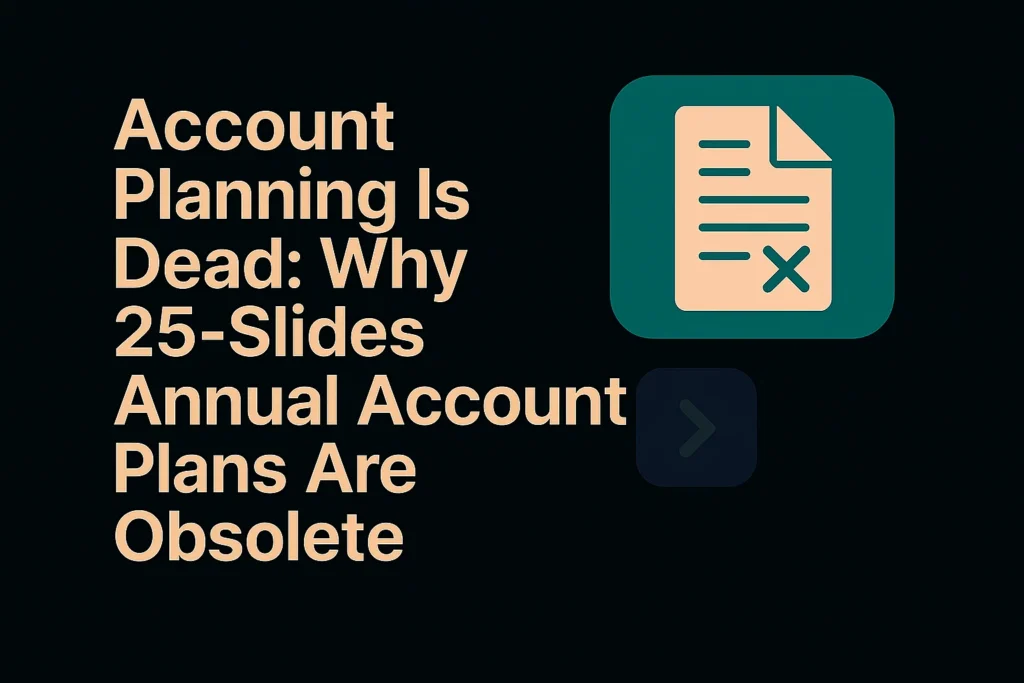
The modern B2B world in 2025 is moving at the speed of AI software updates. Product launch cycles that once spanned three years are now compressed into six months or less, responding instantly to a market that is dynamic, unpredictable, and often non-linear. In this high-velocity reality, for a strategic function as critical as Key Account Management (KAM), clinging to the ritual of the annual 25-slide account plan becomes a strategic handicap. Here’s the hard truth: the annual account planning is dead. In today’s environment, the account plan you meticulously finalized in December might be invalidated by a geopolitical shift, a competitor’s surprise launch, or a major economic tariff by April. Originally, these static account plans were aligned with key customers’ long-term strategic initiatives and value creation possibilities. But the problem today? The world isn’t annual or long-term anymore. – Markets shift rapidly – Priorities evolve overnight – New product launches happen in months, not years – Competitive landscapes change continuously The Need for Monthly Agility in KAM I have never seen the annual account plans fail so quickly because the world itself has become far more dynamic and less predictable. Today’s situation demands that strategic key account managers operate on a monthly, insight-based cadence, not an annual one. For any organization serious about running a high-impact KAM program, the path forward is clear: replace static account plan slides with dynamic, data-driven, AI-enabled monthly action plans. This transition is not about incremental improvement; it is about adopting specialized infrastructure that turns continuous intelligence into competitive agility. Key Account Managers now need to be on their toes, reacting and planning in near real-time. This means: – Continuous research enriched into accounts, contacts, relationships, and opportunities – Timely identification of whitespace opportunities and relationship gaps – Alignment on clear and achievable goals month over month – Data-driven, pointed growth goals, trackable action plans instead of lengthy, outdated presentations The companies and managers who can embrace this pace and flexibility are the ones who will win in this unpredictable environment. The Crisis of Staying Stuck: Why Annual Planning Costs You Big Annual account planning fails because it assumes the world stays still long enough for one plan to hold for a year. That’s just not reality anymore. Three things expose this flaw and chip away at your advantage: 1. Navigating Today’s Uncertainty with PESTLE Analysis In today’s fast-changing world, markets are unpredictable. Political shifts, new laws, economic slowdowns, social trends, tech breakthroughs, and environmental challenges all impact your customers’ environment, often overnight. Relying on plans based on data from six months ago is no longer enough. Instead, you need to constantly watch the macroeconomic PESTLE( Political, Economic, Social, Technological, Legal, and Environmental) factors to understand how the landscape is shifting around you. This is the only way to keep your account plans relevant and proactive. Spot emerging risks and growth signals early, and stay ahead in this volatile world. That’s how we win, by understanding the bigger picture constantly, not once a year. 2. The Hidden Cost of Manual Work Annual plans drag account managers down with endless manual research, data wrangling, and presentation-building. This admin overload kills speed and focus. Storing info in scattered spreadsheets and static decks means insights are stale and disconnected from critical customer moments. AI-powered KAM tools automate research and summaries, cutting research time by 40–50%. That frees AMs to focus on strategy and relationships, not clerical tasks. 3. The CRM Mismatch Using general CRM platforms for strategic KAM is a false economy. These tools cover broad sales activities but deliver shallow account planning. Their static templates need costly add-ons to fill gaps, driving up overall cost and fragmenting intelligence. Strategic KAM demands a specialized, intelligent platform built from the ground up for depth and speed. The Future: AI-Powered KAM Coaching for Agility and Depth The fix is laser specialization. KAM needs purpose-built AI-enabled platforms that act as proactive coaches, not passive data stores. Static slide decks? Replace them with dynamic, living account plans that update automatically and deliver real-time insights. Proactive goal tracking? KAM AI keeps tabs on strategic growth objectives, sends you timely reminders, and guides your next best moves with context. Unified intelligence? All your internal CRM data, communication (email, calendar, calls), and external market signals are connected, giving you a factual, 360-degree view of the account. Whitespace discovery? AI analyzes past deals, benchmarks, and broader industry data to identify where growth is possible—visualized in simple heatmaps to guide action. Relationship health? AI turns email and call sentiment into emotional intelligence, mapping influence and detecting emerging risks continuously. Aspect Old Way: Annual Account Planning New Way: Dynamic AI-Powered Monthly Planning Planning Horizon One-year static plan, created once annually Rolling monthly plans continuously updated with latest data Strategy Focus Based on assumptions of market stability Agile, responsive to fast-changing market and customer needs Data Freshness Often outdated data by the time plan is executed Real-time, AI-enriched insights and signals Account Intelligence Manual research, spread across spreadsheets and decks Automated research, unified intelligence from external & internal sources Risk and Opportunity Detection Reactive, annual review of risks and whitespace Proactive risk detection and whitespace prediction via AI Relationship Management Static org charts, manually maintained Dynamic relationship maps with sentiment and engagement analytics Goal Tracking Basic, manually tracked; often disconnected AI-driven goal tracking with reminders and actionable guidance Administrative Overhead High, time-consuming manual effort Low, majority of research and data entry automated Technology & Tools Basic CRM features and static templates Specialized KAM platforms with AI coaching and insights Cost High, with costly add-ons and high manual effort Lower, unified platform with significant productivity gains Collaboration and Review Siloed, periodic reviews and static reporting Integrated, continuous QBRs with cross-team collaboration Competitive Edge Limited by static and reactive approach Enhanced by continuous intelligence and agility Why Agile KAM Is Essential Static annual plans are dead because the world demands continuous adaptability. Specialized AI tools unlock efficiency by automating research and intelligence, thus freeing AMs to do what they
The Quarterly Target Trap: Why It’s Killing Your Key Accounts and Could Make Your Company Extinct
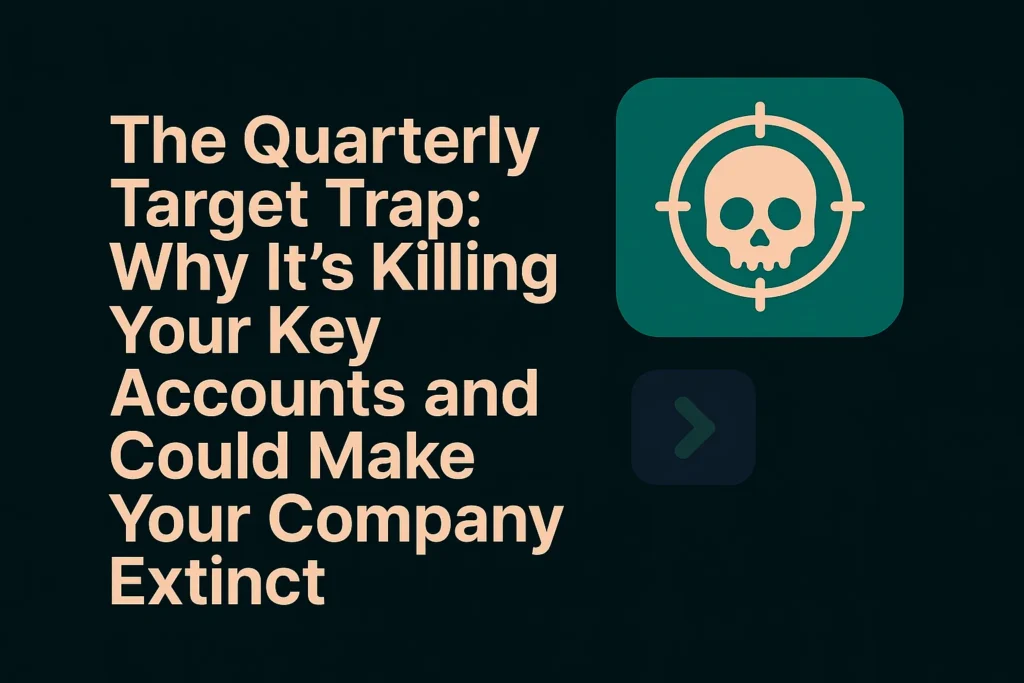
The boardroom pressure is relentless. Every three months, another earnings call. Another set of analyst briefings. Another quarter where the stock price hangs in the balance of whether you beat, meet, or miss expectations by a few pennies per share. But this quarterly obsession isn’t limited to publicly traded companies. Venture capital and private equity-backed firms face their own version of the same pressure – quarterly LP reports, performance metrics updates, and the constant scrutiny of fund managers who themselves are measured on short-term returns. Whether it’s a public company CEO facing Wall Street analysts or a VC-funded startup founder presenting quarterly metrics to their board, the drumbeat has become the heartbeat of modern corporate governance. But it’s slowly suffocating the very initiatives that could transform companies from good to legendary. VC-funded companies operate under a unique form of quarterly pressure. While they don’t report to public shareholders, they face quarterly board meetings where metrics like Monthly Recurring Revenue (MRR), burn rate, and customer acquisition costs are dissected. Fund managers, themselves under pressure to deliver returns to Limited Partners within 7-10 year fund lifecycles, often push portfolio companies toward metrics that show immediate traction rather than long-term strategic positioning. The irony is striking: venture capital, originally designed to fund long-term innovation, has increasingly succumbed to short-term thinking. Fund managers track Internal Rate of Return (IRR) and Total Value to Paid-In (TVPI) on quarterly basis, creating pressure for portfolio companies to optimize for metrics that look good in the next investor update rather than capabilities that drive sustainable competitive advantage. This isn’t just about financial reporting, it’s about a fundamental misalignment between what creates sustainable value and what satisfies immediate stakeholders. The casualties of this quarterly obsession are numerous, but perhaps none more critical than key account management. The Perils of Short-termism: Lessons from Intel & GE’s Downfall Consider this sobering reality: – 88% of Fortune 500 companies from 1955 have vanished. – Half of the Fortune 500 companies that existed in 2000 are gone today. These weren’t failing businesses when they disappeared; many were profitable, growing, and seemingly unstoppable. Yet they’re gone. – In the late 1970s, the average tenure of an organization on the S&P 500 index was approximately 35 years. Today, that average tenure is hovering closer to 20 years, with some projections forecasting a drop to as low as 12 years by 2028. What happened with Intel? Intel provides a perfect case study. In 2001, Intel was a tech titan, a cornerstone of the original Fortune 500 tech boom. Today, it’s fighting for survival. The company that once dominated semiconductors now trades at a fraction of its former glory, with a market cap that has plummeted as competitive pressures from TSMC, AMD, and others have eroded its position. Intel’s decline wasn’t sudden. It was the result of years of decisions optimized for quarterly performance rather than long-term strategic positioning. The company missed the mobile revolution, fumbled the AI boom, and watched as more agile competitors captured the markets of the future. General Electric under Jack Welch GE under Jack Welch provides the perfect cautionary tale. Welch became a corporate icon by delivering 80 consecutive quarters of earnings growth, but this success ultimately masked a systematic short-termism that eventually led to the company’s destruction. Research shows that GE’s earnings consistency was achieved through financial engineering rather than operational excellence. The company used GE Capital to smooth quarterly results, making acquisitions and disposals to hit earnings targets rather than building sustainable competitive advantages. When the financial crisis hit, this house of cards collapsed spectacularly. The Welch era illustrates how quarterly obsession can create the illusion of success while hollowing out a company’s core capabilities. By 2020, GE’s market capitalization had fallen 55% from its peak, and the company that once exemplified American industrial might had become a cautionary tale about the dangers of short-term thinking. I would highly recommend the book The Man Who Broke Capitalism by David Gelles, which compellingly explores how the short-term, quarterly earnings-focused leadership style epitomized by Jack Welch’s tenure at GE significantly contributed to the company’s eventual decline, offering critical insights into the dangers of prioritizing immediate financial performance over sustainable, long-term value creation. How Quarterly Focus Hinders Key Account Management Key account management is inherently a long-term play. It requires nurturing deep relationships, understanding evolving customer needs over the years, and investing upfront in tailored solutions. The conflict between short-term urgency and long-term account development creates a dangerous gap: companies lose the ability to proactively identify growth opportunities within existing key accounts, leading to stagnation and increased vulnerability to competitors. Warren Buffett and Jamie Dimon captured this perfectly in their 2018 Wall Street Journal op-ed: “Quarterly earnings guidance often leads to an unhealthy focus on short-term profits at the expense of long-term strategy, growth, and sustainability”. They weren’t talking theory; they were describing the lived reality of thousands of corporate boardrooms where long-term initiatives get sacrificed on the altar of quarterly results. Leading organizations that embrace mature KAM practices prioritize periodic, structured account reviews and multi-department collaboration, enabling them to maintain the rhythm of relationship management regardless of short-term sales cycles. These companies view KAM not as a tactical program but as a strategic capability essential to sustainable growth. Yet under quarterly pressures, organizations: – Focus disproportionately on new business acquisition or short-term pipeline metrics that boost immediate revenue. – Conduct detailed monthly pipeline and deal reviews but rarely engage in systematic KAM QBR cycles. – Treat key account initiatives as discretionary or tactical, vulnerable to cost-cutting during quarterly performance shortfalls. The Effects of Neglecting Key Account Management When KAM is sidelined, organizations lose their most profitable growth engine. Research shows: – Revenue from key accounts typically grows 20-30% after mature KAM adoption. – New business from existing key accounts has a 60-70% higher close likelihood than cold prospects. – Customer acquisition costs are 5-7 times higher than retention costs, making KAM acceleration a cost-effective growth lever. Ignoring KAM not only lowers current revenue potential but also weakens the organization’s strategic moat.
From Instinct to AI – My 25-Year Journey Watching the Evolution of Key Account Management
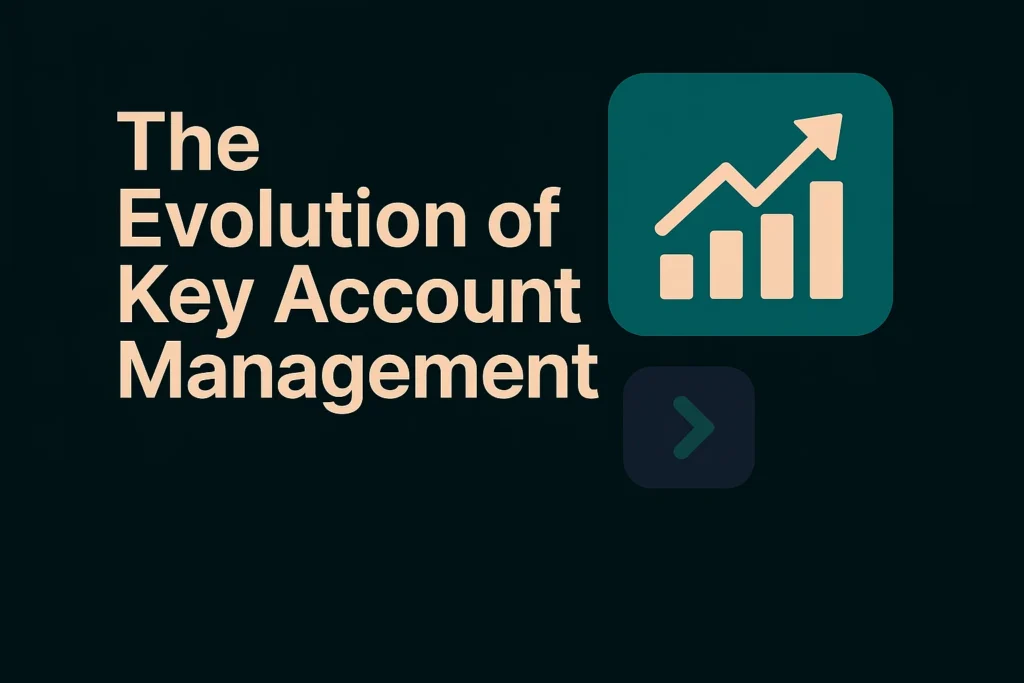
It has been a quarter century since I first started working as an account manager with large B2B accounts. My career has been defined by the pursuit of transforming Key Account Management (KAM) from an art form reliant on individual genius into a reliable, repeatable science. I have seen the KAM landscape change drastically, and while every era brought its own set of challenges, the pace of transformation happening right now, and what is coming next, is simply unprecedented. When I started, the greatest vulnerability was institutional memory, or the lack thereof. We knew that relying on guesswork or hope for those key relationships was a massive business risk. My journey has been a quest to systemize strategic growth, leading me to track what I view as six distinct, seismic leaps in how we approach account relationships and the tools we use to manage them. These phases show how we have leveled up our tools and mindset, one monumental step at a time. The Evolution of Key Account Management Phase 1: Tribal – The Age of the Hero Account Manager (AM) The early days, which I call the Tribal phase, was dominated by the Hero AM. I will start with a memory of a colleague I’ll call Jay. Jay was a legend. His success was built purely on his innate instinct, incredible memory, and deep personal relationship skills. He knew his account and the buyers inside out, understood their political landscape, and navigated organizational complexities seamlessly. But all that intricate knowledge lived exclusively in his head. This reliance on the individual was the core challenge and systemic risk of Phase 1. When organizations rely heavily on the personal skill set of a “hero,” they fail to treat customer knowledge as an institutional asset. Without broad, organization-wide standards for KAM, systemic and repeatable success was fundamentally unachievable. The inherent risk was massive, and we lived in constant fear of it. If Jay left, all that invaluable intel, the nuanced history, the personal connections, and the relationship capital would simply be gone with him. We suffered from predictable failure modes, specifically the slow transfer of knowledge and the inadvertent omission of critical strategic steps when a new AM took over. The organization was consistently vulnerable, dependent on a few non-transferable personalities to drive its most valuable 80% revenue. Phase 2: The Excel Wave – PPTs & Spreadsheets Our first attempt to mitigate the massive organizational risk of the Tribal phase was documentation. This ushered in Phase 2: the age of PPTs and Spreadsheets. Account plans were meticulously constructed on slide decks, and growth strategies, including relationship and pipeline planning, were mapped out in complex, color-coded sheets. This documentation offered an initial sense of clarity, but it was static and quickly proved unscalable. I vividly recall the agony of preparing for quarterly business reviews(QBRs). Preparing for a QBR meant, AMs would spend days and deal with multiple, conflicting versions of the same file, leading to confusion and errors. Critical client history was frequently buried, lost, or overwritten because the data lacked the necessary relational structure required for complex account management. The central issue was the structural limitation of PPTs & spreadsheets. Key Account Management is fundamentally about managing complex, interconnected relationships- the shift from tactical interaction to strategic association. Spreadsheets, designed for simple rows and columns, are structurally incapable of handling the complex, multifaceted data relationships needed to seamlessly link customer interactions, sales history, and support tickets. This inflexibility meant that as soon as the business grew, the system broke. We could document things, but we certainly could not share, scale, review, or standardize those static plans across the organization. The result of this chaos was wasted time, lost growth opportunities, and poor client experiences where customers grew frustrated having to re-explain their needs and history repeatedly. Here is a perfect, hilarious example of mishaps that happened more often than you think in Phase 1 & Phase 2 Phase 3: The System of Records – Powered by CRMs The arrival of Customer Relationship Management (CRM) systems in Phase 3 marked the great leap into the System of Record. This centralized data and promised to pull us out of the version control nightmare of spreadsheet purgatory. However, a great paradox quickly emerged. While CRMs were excellent at Lead Management, Opportunity Management, and Sales Pipeline Tracking, they fundamentally lacked the process and functionality required for strategic Key Account Management. Strategic KAM demands looking at the big picture for large, complex accounts, focusing on creating growth/expansion strategies and integrated relationships. The CRM left a significant “account planning gap.” I remember a client, a large IT services firm, whose Salesforce CRM was diligently updated with transactional data, yet their organizational structures, relationship maps, and strategic growth planning existed entirely outside the system, scattered in PPTs & Excel. The fundamental misalignment was that these Phase 3 CRMs focused on selling (Opportunity Management) rather than growing (Account Planning). This forced AMs back into the tedious, heavy lifting of manual data entry and separate processes for strategic planning. The AMs felt the system worked against them, demanding labor but giving back little strategic clarity. This strategic misalignment confirmed the need for specialized technology that could move beyond merely tracking deals to visualizing the breadth and depth of key account relationships. Phase 4: The System of Records – Powered by KAM tools The strategic gap left by mainstream CRMs demanded a critical intervention: the emergence of specialized KAM platforms built around the central theme of customer-centricity. This is where tools designed to facilitate strategic account planning & growth, like Demandfarm, began to redefine the landscape. KAM tools were specifically built to enable AMs and sales leaders to move from reactive to proactive account planning. All the account growth plans were transformed from rarely updated static spreadsheets and CRMs to living and breathing plans synced & updated in real-time. No more battling through endless versions of PPTs and Excel to prepare for QBRs. KAM tools enabled account management teams
Why Key Account Managers Need AI as a Copilot, Not a Pilot
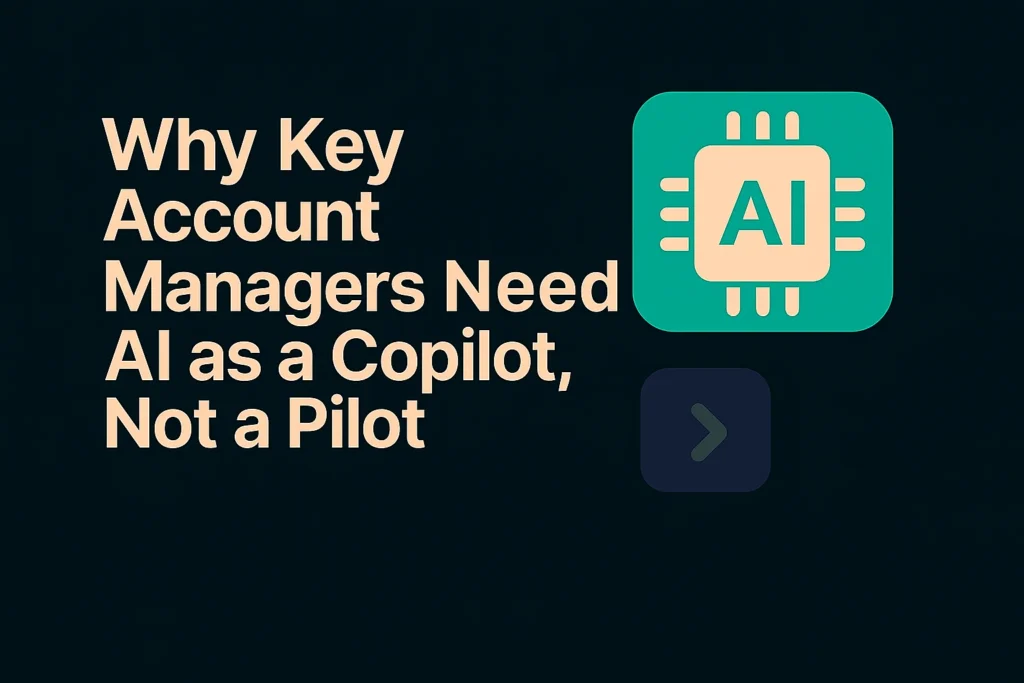
“AI isn’t intelligent in the way we think it is. It’s a probability machine. It doesn’t think. It predicts. It doesn’t reason. It associates patterns. It doesn’t create. It remixes.” – Shubhransh Rai on Medium This statement from Shubhransh Rai’s blog hit me like a revelation. It’s blunt and true. And it drew a line in the sand for me while building AI tools for key account management. Seeing Through AI’s Limitations in Key Account Management I feel we are living in the age of big promises. AI will outthink us, outsmart us, automate away all strategic complexity, at least that’s the story we hear daily. But as someone who’s spent decades with account managers, one thing is clear: AI isn’t the master of complex B2B relationships or growth strategy. AI is a pattern recognition machine. It shines at prediction, association, and remixing, but it cannot reason deeply through dynamic business-to-business relationships or invent new growth strategies when the landscape shifts. Key Account Management (KAM) is a nuanced blend of art and science. Operational tasks, such as tracking organizational structures, managing relationships, analyzing whitespace, and forecasting sales, can overwhelm AMs. AI promises to alleviate much of this grind. But as DemandFarm’s AI product Kampanion exemplifies, success lies in a clear division: what AI should do versus what only skilled account managers can accomplish. Use-cases of AI in KAM: Automate, Predict, and Surface Insights AI excels at tasks centered around pattern recognition, data processing, and predictive analytics. AI is instrumental in helping complex KAM programs scale and cross-pollinate best KAM practices across the organization. Here’s where AI delivers the most impact, and where DemandFarm’s Kampanion AI is already actively helping customers: Recognizing Patterns and Finding Growth Whitespace AI can sift through external macroeconomic and microeconomic factors, as well as historical sales and growth data across buying centers, geographies, verticals, and accounts, to identify real whitespace opportunities that appear promising but remain untapped. Kampanion leverages this by analyzing past wins, competitor presence, and product mix to suggest high-potential areas to explore. Surfacing Risks and Predicting Sentiment Customer sentiment analysis is a growing use case where AI monitors emails, calls, communication patterns, social feedback, and not just NPS to alert account managers about shifting moods or a potential churn risk. Kampanion AI can quantify account health and flag at-risk relationships before manual oversight would catch them. Auto-Building Visual Org Charts from Contact Lists One of the traditionally manual, time-consuming parts of account planning is building relevant and accurate relationship maps. AI not only automates the creation, but also updates these org charts on job changes and highlights key influencers and detractors. DemandFarm’s Kampanion AI keeps these updated in near real-time, reflecting organizational changes as they happen. Cross-Polinate KAM Best Practices Across The Organization AI compiles lessons from thousands of previous account plans, identifies growth patterns, remixing proven strategies and tactics into actionable recommendations. When to engage a particular stakeholder, or which product bundles have historically sold well in which buying centers. These recommendations support decision-making but do not make decisions for account owners. Predictive Sales Forecasting and Opportunity Scoring Combining win-loss data with customer behavior signals and opportunity playbook, AI can forecast the likelihood of your growth & expansion deal closure and assign risk scores to opportunities & accounts, enabling better resource prioritization. Personalized Customer Communication Suggestions By analyzing customer interactions – emails, calls – AI can propose personalized messaging strategies and cross-selling / upselling recommendations to maximize engagement effectiveness. Voice of the Account Analytics Sentiment and theme analysis across emails, surveys, and call transcripts help deepen contextual understanding beyond raw CRM data. Such AI-driven functionalities are not just theoretical. DemandFarm’s Kampanion AI already delivers these capabilities, tightly integrated with any CRM, ensuring account teams get contextual, timely insights fused with their existing workflow. What Key Account Managers Must Handle in KAM: Strategy, Empathy, and Complex Judgment While AI handles the heavy lifting, key account managers must own the uniquely human aspects that no algorithm can replicate: Creating Entirely New Growth / Expansion Strategies Account managers have the contextual knowledge and creativity to craft bespoke strategies, recognizing market shifts, global macroeconomic developments, new business models, or emerging customer needs. AI can never fully see beyond historical data or understand subtle strategic shifts on the horizon. Navigating Complex Relationship Networks with Empathy Understanding the politics, personalities, and emotional dynamics among stakeholders within customer organizations is a critical human skill. Building trust, reading unspoken cues, and managing changing agendas require intuition and empathy. Influencing Renewal, Expansion, and Advocacy Timing, persuasion, and negotiation are art forms shaped by experience. Relationship advocacy to secure wallet share or renew contracts depends on nuanced, situational judgement where human interaction is essential. Understanding the “Why” Behind Customer Behavior AI can flag behavior changes, but can’t explain motivation or intent in full. Account managers interpret data alongside broader market context, company strategy, and personal relationships. DemandFarm’s Approach: AI as a Copilot, Not the Pilot When we built Kampanion, this philosophy was fundamental. Kampanion predicts the next best contact to engage, maps influence networks automatically, and surfaces potential white space and risks. But it does not decide the strategy. The key account manager remains in charge of strategy, vision, relationships, and judgment. This balance lets teams focus on what they do best while AI lifts operational burdens and alerts them to what matters most. Why This Matters Today McKinsey predicts AI will replace up to 30% of work hours by 2030. For key account managers who require both strategic thinking and relationship nuance, AI in KAM will automate the operational while enhancing the strategic. Studies show 84% of KAMs today spend most of their time on admin and operational tasks. AI-powered tools like Kampanion are the game-changers that unlock precious time for strategy and relationship-building. The future of KAM isn’t AI replacing people. It’s AI empowering humans to get smarter, faster, and more creative. Let AI handle pattern recognition, prediction, and automation. Let humans steer strategy, empathy, and judgement. That’s how you unlock the full power of AI to
Top Key Account Management Apps for Hubspot
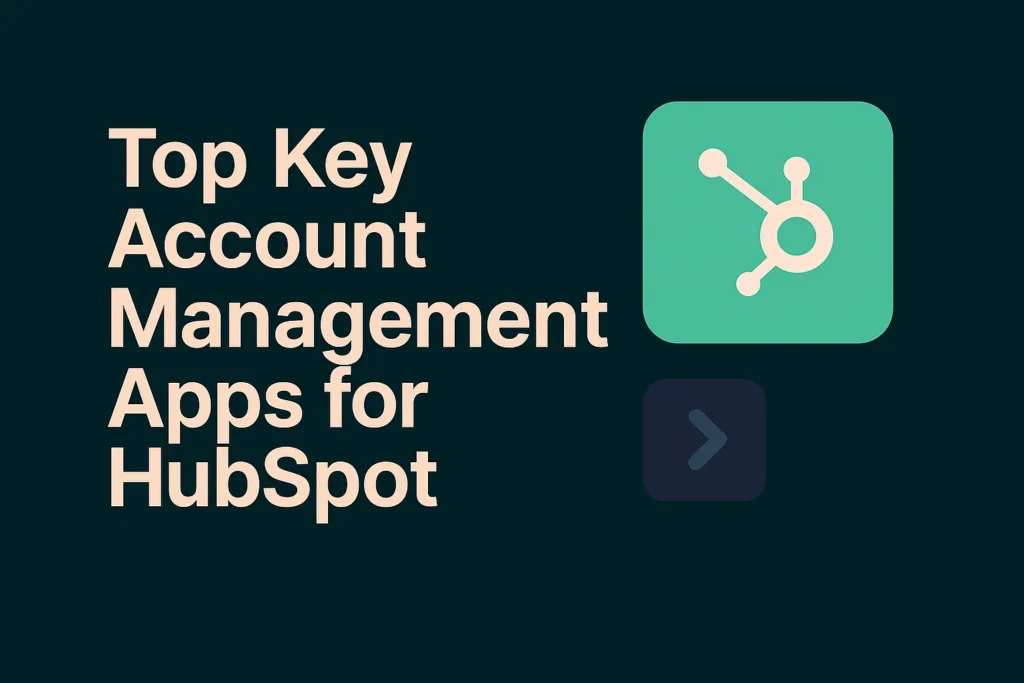
Ever felt like CRM alone isn’t enough to grow your top-tier key accounts? I’ve spent a decade watching account plans vanish into PPTs and relationships fade in the chaos of scattered contact data. Key Account Management isn’t just a sales tactic, it’s the secret to unlocking real, compounding growth from your most valuable customers. The right apps paired with HubSpot CRM can transform static account plans in ppts into living, breathing, dynamic account plans. If you have a key account management program and are ready to expand revenue from your strategic accounts, have a look at these top key account management tools that transform HubSpot into a true growth engine for key accounts. Why HubSpot Users Need Dedicated Key Account Management Tools HubSpot equips teams with robust CRM functionalities such as lead and deal management, email marketing, sequences, and marketing automation. However, when dealing with large, multi-stakeholder, complex key accounts, traditional CRMs like HubSpot can fall short in guiding strategic account managers. This is where purpose-built KAM apps add value. They transform static account data into dynamic, actionable insights that uncover hidden relationships, quantify stakeholder influence, flag potential risks, and uncover untapped growth. These capabilities reduce surprises, enable tailored engagement plans, and make cross-functional collaboration around key accounts more systematic. Top 3 Key Account Management Apps for Hubspot 1. DemandFarm: AI-Powered Account Management App for HubSpot DemandFarm is a top-tier Key Account Management app deeply integrated with HubSpot CRM. It takes account planning, org chart mapping, and stakeholder management to the next level through an AI-powered copilot and seamless syncing with HubSpot data. Core Features: AI-Generated Org Charts & Relationship Maps: Automatically visualizes the reporting structure, key influencers, champions, and blockers within an account. This AI-driven mapping helps sales teams target the right stakeholders and prioritize outreach based on real engagement. Engagement Matrix: DemandFarm tracks interactions such as emails, meetings, and calls in HubSpot, then uses these patterns to create heatmaps showing where relationships need nurturing. This intelligence is critical for forecasting deal success and managing long sales cycles. Comprehensive Account Planning Modules: DemandFarm’s Account Planner and Whitespace Planner tools help users set goals, monitor progress, and identify growth opportunities within each key account. This structured approach brings discipline to otherwise ad hoc planning processes. Seamless HubSpot Integration: The app syncs contacts, companies, deals, and activities bi-directionally with HubSpot CRM. This eliminates manual data entry, mitigates risk of stale or siloed data, and surfaces insights directly in the tools sellers use daily. Other Key Account Management Apps for HubSpot 2. Kapta Kapta is an account management tool designed to help teams drive strategic account growth and customer success. It offers interactive org charts, goal setting, account health scoring, and customizable planning templates. Built on CRM principles, Kapta streamlines account management processes and supports collaboration across sales and customer success teams. Its robust analytics and risk monitoring tools help ensure alignment and focus on revenue expansion within key accounts. 3. OrgChart Hub OrgChart Hub is a focused organizational chart tool built specifically for HubSpot users looking to visualize and manage complex account hierarchies. It enables account managers to create detailed, interactive org charts within the HubSpot CRM. While it does not offer broader key account management features like planning or health scoring, OrgChart Hub excels at providing clear visibility into stakeholder structure and reporting lines, making it a great option for teams that prioritize relationship mapping. Conclusion: HubSpot is a powerhouse for managing contacts and deals. But serious key account management requires tools that go beyond basic CRM features. Selecting the best key account management app for Hubspot depends on your key account management program, complexity, and strategic priorities. DemandFarm is a purpose-built key account management platform trusted by thousands of KAM practitioners over the last decade. It offers deep AI-powered relationship mapping and account planning that goes far beyond standard CRM capabilities. Seamlessly integrated with HubSpot, DemandFarm helps teams tackle complex buying units, pinpoint key influencers, and execute disciplined, data-driven account growth strategies. Backed by a solid AI roadmap with Kampanion, DemandFarm turns your CRM data into powerful, actionable insights, making it the ultimate tool for serious key account managers focused on predictable revenue growth.
Salesforce Account Plans Explained: Features, Limitations & DemandFarm Comparison
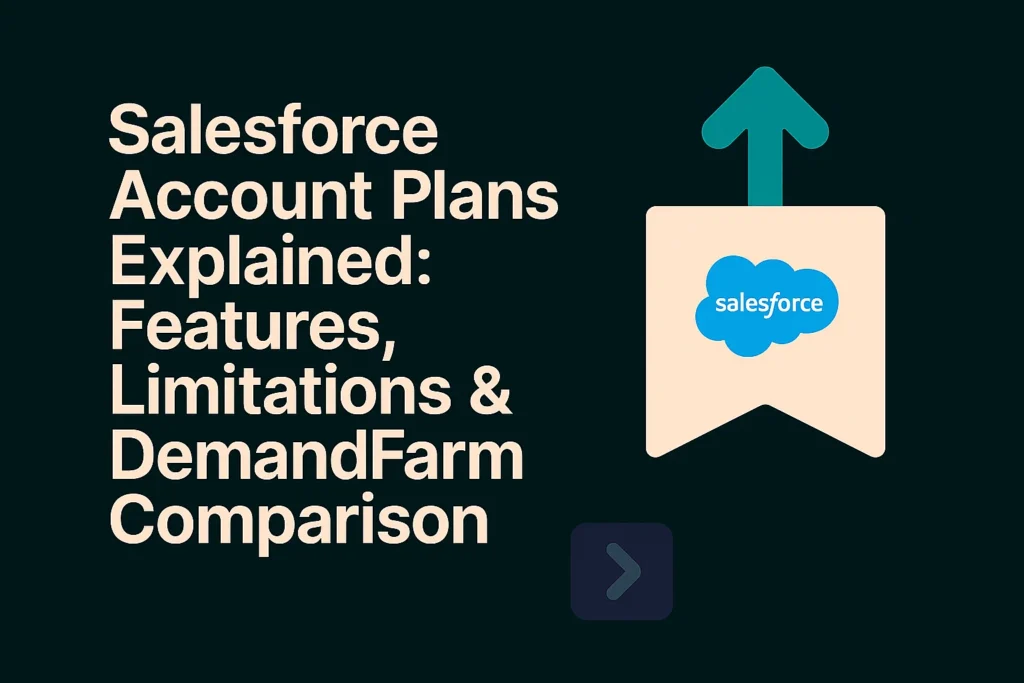
What are Salesforce Account Plans? Salesforce introduced Account Plans in Salesforce Sales Cloud as a native account management, account planning, and relationship mapping module. This move addresses a clear market need for account management tools and aims to streamline account planning within the CRM. In my view, Salesforce Account Plans are a basic, beginner-level option – a good starting point for account management teams looking to organize their work inside Salesforce without the external chaos of spreadsheets and slides. You get planning, collaboration, and relationship mapping all in one place. However, organizations serious about key account management (KAM), those seeking truly proactive, AI-guided, and high-impact account planning will find specialized tools like DemandFarm offer a significant leap forward. View entire thread here What are the Key Features of Salesforce Account Plans? Centralized Collaboration: All key account information is stored in one place to ensure team alignment and better cross-functional collaboration. Strategic Planning: Built-in SWOT (Strengths, Weaknesses, Opportunities, Threats) sections help teams understand their customer’s market position and challenges. Clear Objective Setting: Define measurable goals with owners, deadlines, and live progress tracking to keep your team accountable. Relationship Mapping: Visualize key stakeholders and relationships within accounts—a must-have for complex B2B sales cycles. Reports & Dashboards: Native Salesforce reports and dashboards provide real-time insights into account health and progress against goals. Why Salesforce Account Plans, Though Essential, Fall Short for Serious Key Account Management Salesforce Account Plans deliver a “foot-wide, inch-deep” solution, tackling account management at a surface level. The module currently lacks the depth and maturity needed to manage complex buyer relationships in global, strategic accounts. Challenges often faced by organizations include: Surface-level planning: Covers many accounts but doesn’t penetrate the nuance of complex key accounts. Feature immaturity: Core KAM capabilities such as advanced relationship intelligence, white space discovery, and AI-driven prioritization are limited, primitive, or absent. Unclear product roadmap: Signals within the Salesforce ecosystem suggest KAM features have low priority, casting doubt on their future evolution and long-term reliability. As a result, serious KAM practitioners often feel constrained by broad tools that don’t enable them to dig deep. View entire thread here DemandFarm – A Better Alternative to Salesforce Account Plans For Serious Key Account Management DemandFarm is purpose-built over years of partnership with thousands of KAM practitioners across industries, zooming into every pain point and use case. There’s no major account management challenge or feature we haven’t thoughtfully addressed. At DemandFarm, we reject the myth of superficial breadth. We believe in brutal focus. We choose to go “foot deep, inch wide.” What does that mean for Key Account Management? It means instead of broadly touching 50 problems, we dive 100 feet deep into the one that truly drives your growth. We dissect relationship dynamics, pinpoint exact whitespace opportunities, and build AI co-pilots that understand the nuanced dance of strategic accounts. Here’s a great summary from a Sales Ops leader at a tech enterprise who evaluated both Salesforce Account Plans and DemandFarm: Our KAM-focused tools are designed to deliver depth where it matters most: White Space Discovery: Uncover hidden revenue expansion opportunities often missed by broader generic tools. Relationship Visibility: Map organizational dynamics and track nuanced shifts in influence, stakeholder sentiment, and power. AI-Powered Insights: Unlock Key Account Intelligence locked up in your sales tools. Unlock answers, insights, and next steps from CRM, calls, and emails, so your AMs can stop spending hours chasing data and focus on strategic activities. AI-Powered Guidance: Receive next-best-action recommendations that focus your team on high-impact activities. Collaborative Workflows: Align sales and cross-functional teams to execute sharply on account priorities and strategies. As Sean Neighbors, SVP of Global Product Offerings, TaskUs aptly put it: “DemandFarm is all the things I wish Salesforce did for account management from the start. DemandFarm brings all the effort put into Salesforce to light in a simple and easy format.” How DemandFarm stands out as the most powerful and purpose-built software for key account management 1. Specialized AI for Deeper Insights and Guided Actions: – Kampanion AI: DemandFarm’s Kampanion AI Assistant provides a single search interface for all your sales tools, delivering contextual account and relationship intelligence, and guiding Account Managers with next best actions for account growth. – KAM AI: Beyond simple automations, DemandFarm’s KAM AI intelligently relieves AMs from “grunt work,” offers deal risk insights to course-correct on time, and provides contextual insights for swift, impactful action. This is a more mature and integrated AI capability compared to Salesforce’s upcoming Agentforce integrations for some account planning features. 2. Uncovering Unseen Opportunities with Purpose-Built Tools: – White Space Planner: DemandFarm Account Planner explicitly helps you “uncover revenue expansion/growth opportunities with Heatmaps” and bring alignment on strategic objectives with Growth Plans, allowing for timely course-correction with In-app QBRs. This specialized focus on whitespace analysis is critical for maximizing account potential. – Advanced Relationship Maps: While Salesforce offers a Buyer Relationship Map, DemandFarm’s Relationship Maps go deeper. They auto-create maps to “uncover people dynamics(influence, power, affinity) in key accounts,” provide full visibility into the buying committee with opportunity-specific maps, and offer engagement analytics to know who to reach out to. Customers rave about DemandFarm’s org chart tool for understanding relationships qualitatively and engage with the right people in large key accounts. – Opportunity Planner: DemandFarm’s Opportunity Planner enables you to “implement any sales methodology with Scorecards,” get the “complete story of an opportunity” with Playbooks, and visualize opportunity-specific stakeholders with Stakeholder Maps. This structured approach ensures sales methodologies are consistently applied and opportunities are thoroughly managed. 4. Holistic Account Growth and Proactive Planning: – DemandFarm is engineered to help you “go from reactive to proactive account planning”. It drives tangible results, including an increase in cross-sell and upsell opportunities, an uptick in total pipeline creation, and improved attainment of revenue targets and deal win rates. – The platform empowers you to “unbox the full revenue potential of your top 20% accounts”, providing the tools necessary to grow your most valuable client relationships strategically. 5. CRM Agnostic Flexibility and Enterprise-Grade Reliability: While DemandFarm is 100% Salesforce-native, it also integrates with every other CRM. Trusted by “250+
Prolifiq’s Discontinuation: Finding a Path Forward with the Right Alternative
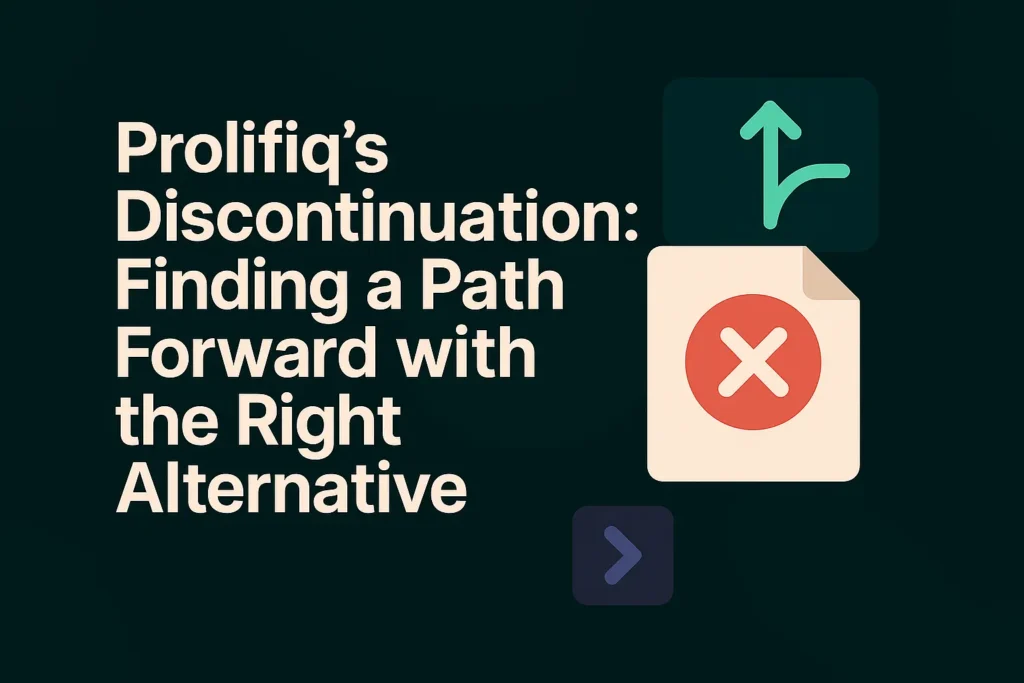
I was saddened to hear the news about the discontinuation of Prolifiq.ai. As a founder and a peer in the strategic account management space, you never want to see a company that has worked so hard to build a product and customer base close its doors. My sincere empathy goes out to the Prolifiq team and, most importantly, any Prolifiq customers now searching for an alternative solution. Why Prolifiq Alternatives & Competitors Must Evolve I’ve always admired Prolifiq’s mission. Their work was instrumental in helping account managers move beyond the “status quo” of scattered spreadsheets and static slide decks. They evangelized the idea that account plans & strategic relationships should live inside Salesforce, turning a basic CRM into an “account-based selling command center”. This was a critical step in the evolution of sales technology, moving the industry forward from what I call the “PPTs & Spreadsheets” phase to the “System of Record” phase. I recently wrote a full post highlighting the 6 phase of this jouney on my LinkedIn here. However, this shift also came with a core challenge. These “systems of record” were often built for leaders to gain visibility and enforce processes from the top down. As a result, they frequently burdened sales reps and account managers with tedious manual data entry, leading to low adoption and high churn. The effort required to input and maintain data often outweighed the perceived value for the seller. It was difficult to quantify the impact of this manual work, and sellers were left logging information without a clear, immediate benefit to their day-to-day activities. But the industry is now moving into a new era: the “System of Intelligence” and the “AI Co-Pilot.” This is where the manual work is eliminated, and the tool actively helps the seller win. At DemandFarm, we are at the forefront of this transformation, building AI-powered solutions that empower, rather than just govern, account managers. The AI-First Approach: A New Era for Account Planning with DemandFarm At DemandFarm, we’ve focused on building the next generation of account planning solutions. We believe the future of this space isn’t just about organizing data; it’s about making that data intelligent and actionable. This is why we’ve invested heavily in our AI roadmap and are seeing phenomenal results with our new product, DemandFarm Kampanion AI. Kampanion AI is purpose-built to solve the exact problems that traditional tools like Prolifiq faced, transforming account planning from a chore into a competitive advantage: 1. Beyond Manual Data Entry: Instead of making your team spend time logging information, Kampanion AI automates the grunt work. It can perform a unified search across all of your siloed sales tools—from CRM and meeting transcripts to emails—to give you a cohesive, real-time view of your accounts. 2. Proactive, Not Reactive: Where a static tool might show you an account’s history, Kampanion AI provides a dynamic, proactive co-pilot. It analyzes engagement trends and activity to provide real-time risk intelligence, highlighting which accounts need attention and identifying at-risk whitespace before it’s too late. 3. Scalable Relationship & White Space Intelligence: Prolifiq’s Relationship Map was a great start, but it was known to become “a bit clunky” as accounts grew larger. Our Kampanion AI, with its built-in Relationship Intelligence and White Space Intelligence, synthesizes data patterns to provide predictive recommendations, helping you identify untapped champions and new expansion opportunities, even in your largest accounts. We’re already receiving incredible feedback from our customers, including some of Prolifiq’s former clients, on how Kampanion is a “game-changer” that empowers their account managers to become strategic advisors. A Seamless and Supported Transition for Prolifiq Customers We know that selecting a Prolifiq alternative is a major decision, and we are committed to making this transition as easy and low-risk as possible for you. The market is consolidating, and with the Salesforce AppExchange landscape shifting, finding a stable, long-term partner is more critical than ever. The DemandFarm team is already supporting a number of former Prolifiq customers, and we are here to help you, too. We have a dedicated process to ensure a smooth migration, and we are prepared to waive certain transition costs and match your previous pricing to ensure your strategic account management and relationship mapping efforts can continue without interruption. This is more than a simple switch. This is an opportunity to move from a static, manual process to a truly intelligent, AI-first system that will grow with your team. If you are a former Prolifiq customer looking for a partner with a solid AI roadmap and a genuine commitment to your success, I invite you to reach out to my team. We would be honored to show you how DemandFarm and Kampanion AI can serve as your new strategic partner, helping you achieve a level of success that goes far beyond what was possible before. Schedule a demo with the DemandFarm team here